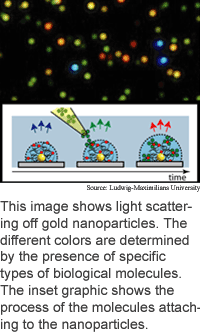
Gold speck highlights molecules
How do you sense what is happening at the
scale of molecules, which are thousands of times smaller than microscopic
objects like red blood cells?
Researchers from Ludwig-Maximilians University in Germany have found
a way to detect the very small spectral shifts that occur when the light
scattering off a single gold nanoparticle interacts with molecules.
The device makes it possible to detect molecular changes in real-time.
The method could eventually be used to make arrays of devices that very
quickly sense many types of molecules at once.
The researchers used a 40-nanometer nanoparticle coated with biotin,
which combines with a second molecule -- streptavidin. They were able to
sense the slight change in red light -- a red shift -- caused when the molecules
bound together and changed the way the light around the nanoparticle refracted,
or bent. Forty nanometers is more than 100 times smaller than a red blood
cell, and is the span of 400 hydrogen atoms.
This is sensitive enough to detect fewer than fifty molecules
undergoing a binding process, according to the researchers.
The work appeared in the May 30, 2003 issue of July 9, 2003 Nano
Letters.
Display brighter than film
Sponges grow sturdy optical fiber
Electron teams make bigger qubits
Vision chip shines
News briefs:
VR system grabs 3D video
Quantum computing has limits
Gold speck highlights molecules
Neural net tracks skin color
Nano thermometer withstands heat
Light drives electron logic

Research Watch blog
View from the High Ground Q&A
How It Works
RSS Feeds:
News
Ad links:
Buy an ad link
Ad links: Clear History
Buy an ad link
|
TRN
Newswire and Headline Feeds for Web sites
|
© Copyright Technology Research News, LLC 2000-2010. All rights reserved.